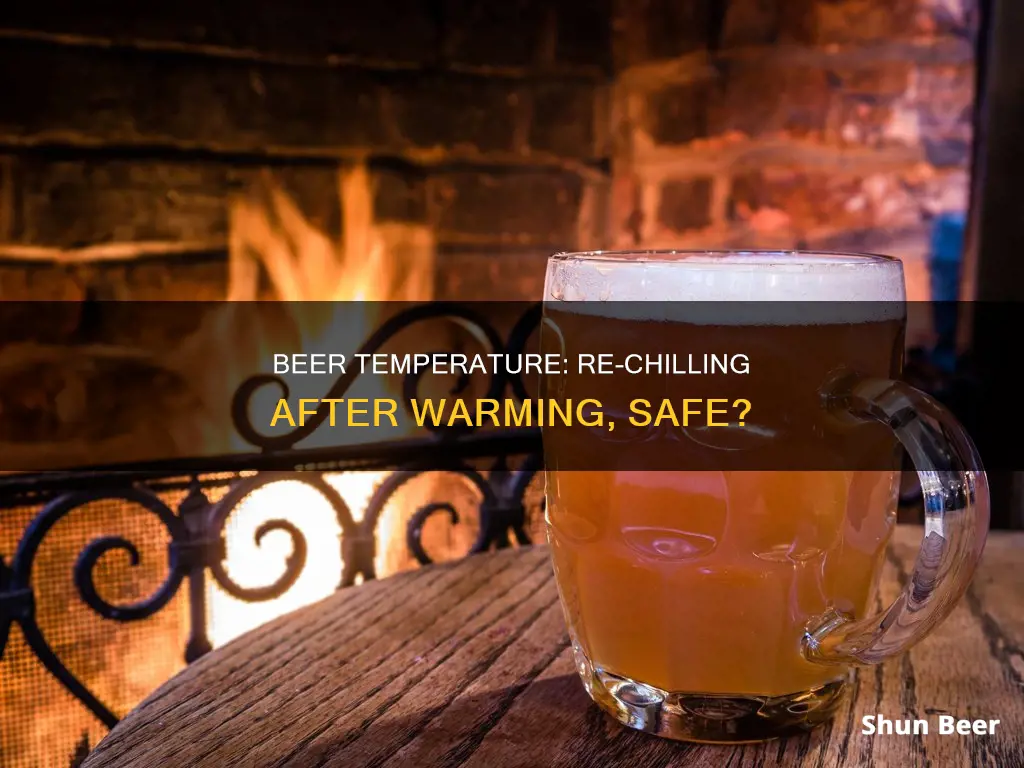
It is a common misconception that beer cannot be consumed after it has been chilled and then allowed to return to room temperature. This myth likely stems from the belief that temperature cycling skunks beer, but in reality, it has little to no effect on its freshness. Beer is best preserved when kept cold, as it extends its shelf life, but allowing it to warm up and then cooling it again will not significantly alter its taste or cause any harm. However, beer enthusiasts argue that rapid temperature changes and prolonged exposure to warm temperatures can affect the flavour and quality of the beer.
| Characteristics | Values |
|---|---|
| Can you drink beer after it's been cold then warm? | Yes, it is a myth that beer cannot be drunk after it has been cold and then warmed. |
| Effect on beer quality | Beer is best preserved when kept cold. However, it can be stored and displayed warm. |
| Effect on beer flavour | Beer flavour changes over time, and this process is accelerated at warmer temperatures. |
| Effect of temperature cycling | Temperature cycling has little to no effect on beer freshness. |
| Effect of quick temperature change | A quick temperature change from cool to warm is worse for beer than a gradual change. |
What You'll Learn
- Beer can be warmed and cooled multiple times with no ill effects
- Beer is perishable and is best stored cold
- Beer flavour changes over time, and this happens faster at warmer temperatures
- Beer can be safely stored at room temperature, but its shelf life will be reduced
- Beer is unlikely to be harmed by being stored at room temperature and then chilled

Beer can be warmed and cooled multiple times with no ill effects
It is a common misconception that warming and then cooling beer will "skunk" it. In reality, this process will have little to no effect on the beer's freshness. Beer flavour changes over time, and this process is accelerated at warmer temperatures. However, there are no additional chemical reactions caused by temperature changes, so warming and then cooling beer will not impact its flavour, aroma, or mouthfeel.
This myth may have originated from experiences with leftover kegs after parties. A half-empty keg that was dispensed by pumping air into it will start to oxidise, and this process speeds up when the keg warms. As a result, the beer can taste stale within a day or two, even if it is then re-chilled. However, this is not an issue with bottled or canned beer, which is pasteurised to preserve it.
Beer is best preserved when kept cold, as this slows down the processes that impact its flavour. Keeping beer at room temperature can reduce its shelf life from nearly six months to only a few weeks, and exposing it to very warm temperatures can affect its flavour within a couple of days. However, these processes take time, and beer that has been warmed and then cooled will still be safe to drink.
While warming and cooling beer multiple times will not cause any ill effects, it is still best to avoid rapid temperature changes. A quick temperature change from cool to warm can impact the beer's long-term stability. Therefore, it is recommended to keep beer refrigerated to preserve its flavour for as long as possible.
Mixing Oxycodone and Beer: What's the Danger?
You may want to see also

Beer is perishable and is best stored cold
Beer is perishable, and it's best to store it cold. While temperature changes do not have a significant impact on the beer, exposure to warm temperatures does. Beer is best preserved when kept cold, similar to how milk lasts longer in the fridge than on the kitchen counter. Keeping beer at room temperature can drastically reduce its shelf life, while exposing it to very warm temperatures can alter its flavour within a few days.
Although temperature cycling between cold and warm does not "skunk" the beer, it is still preferable to store beer at a steady, cool temperature. Beer flavour changes over time, and this process is accelerated at higher temperatures. The ideal storage temperature for beer is within the range of a standard refrigerator.
It is worth noting that beer can be stored and displayed at room temperature, but it is better to store it cold to prolong its freshness and intended flavour. Additionally, rapid temperature changes from cool to warm can negatively impact the beer's long-term stability. However, this effect is minimal unless the beer undergoes numerous temperature cycles.
Beer enthusiasts often believe that beer cannot be warmed and then chilled again. However, this is a pervasive myth. Beer can be warmed and then cooled without causing any harm to the beverage. It would take multiple cycles of cooling and warming to have a noticeable impact on the beer, and most beer has already experienced several cold-to-warm cycles during transportation from the brewery to the consumer.
Puppies and Beer: A Dangerous Mix?
You may want to see also

Beer flavour changes over time, and this happens faster at warmer temperatures
Beer flavour changes over time, and this process happens faster at warmer temperatures.
It is a common misconception that beer cannot be warmed and then chilled again. This myth may have arisen from the observation that beer left in a warm place can develop a stale taste within a few days. However, this is due to the exposure to warm temperatures, not the temperature cycling itself.
Beer is best preserved when kept cold, as this slows down the processes that affect its flavour. Keeping beer at room temperature can reduce its shelf life from almost six months to only a few weeks. However, it is important to note that temperature cycling alone does not "skunk" the beer. In fact, most beer has already experienced several cold-to-warm cycles during its journey from the brewery to your glass.
Hoppy beers are more sensitive to temperature swings, but 1-2 times of going from cold to room temperature will not affect the flavour if the beer is consumed within 30-45 days. Additionally, it is worse for beer to have a quick temperature change from cool to warm, rather than a gradual change.
Overall, while beer flavour does change over time and this process is faster at warmer temperatures, it is not harmful to the beer to let it warm to room temperature and then chill it again.
Beer Drinking: Liver Damage Risks and Realities
You may want to see also

Beer can be safely stored at room temperature, but its shelf life will be reduced
It is a common misconception that beer cannot be warmed and then chilled again. This is not true. Beer flavour changes over time, and this process happens more quickly at warmer temperatures. However, there are no additional chemical reactions caused by temperature changes, so warming to room temperature and re-chilling multiple times will not affect the beer. If you are drinking it within a few weeks, you will not notice the difference with bottled or canned beer.
Beer is best preserved when kept cold, and its shelf life will be extended. Keeping beer at room temperature can reduce its shelf life from nearly six months to only a few weeks, and exposing the same beer to very warm temperatures can affect its flavour in a matter of a couple of days. The beer will not make you sick, but it might not taste very good. Hop flavours and aromas will be diminished, and malt flavours that used to remind you of chocolate and caramel will begin to meld into a generic "sweet" flavour. In some beers, reminders of wet cardboard and paper can develop.
It is worth noting that beer does not like quick temperature changes. A 30º temperature swing in 5 minutes will definitely affect the beer's long-term stability. Beer prefers to be refrigerated and should be if possible. However, if you are going to consume the beer in the next 30-45 days, 1-2 times of cooling it back to room temperature will not affect the flavour.
Beer and Lamisil: Is It Safe to Mix?
You may want to see also

Beer is unlikely to be harmed by being stored at room temperature and then chilled
It is a common misconception that beer cannot be warmed and chilled again without spoiling. However, this is a myth, and beer is unlikely to be harmed by being stored at room temperature and then chilled.
Beer flavour changes over time, and this process occurs more rapidly at warmer temperatures. However, there are no additional chemical reactions caused by temperature changes, so warming beer to room temperature and then chilling it again will not have any adverse effects. Beer likely undergoes several cold-warm cycles during its journey from the brewery to your glass, and it is still safe to drink.
Beer is best preserved when kept cold, as it extends its shelf life. Keeping beer refrigerated will help maintain its flavour as intended by the brewer. Beer stored at room temperature can reduce its shelf life from nearly six months to a few weeks, and exposing it to very warm temperatures can impact its flavour within a couple of days. However, it is important to note that these changes in flavour are usually minimal and may not be noticeable to most drinkers.
While beer can be safely warmed and chilled again, it is essential to avoid rapid temperature changes. A quick temperature swing from cool to warm can negatively impact the beer's long-term stability. Additionally, beer should be protected from sunlight, as exposure to light can create undesirable flavours.
In summary, beer is unlikely to be harmed by being stored at room temperature and then chilled. While it is preferable to maintain a steady cool temperature, warming and rechilling beer will not significantly affect its quality or safety. However, to ensure the best flavour and longevity, it is recommended to store beer at a consistent cool temperature.
Enjoying Beer and Zoo Lights: What You Need to Know
You may want to see also
Frequently asked questions
Yes, it is safe to drink beer that has been cold and then warmed up. While beer is best preserved when kept cold, temperature cycling has little to no effect on its freshness.
Beer flavour changes over time, and this happens more quickly at warmer temperatures. However, there are no additional chemical reactions caused by temperature changes, so warming and then cooling beer multiple times will not have any added effects.
Keeping beer at room temperature can reduce its shelf life from nearly six months to only a few weeks. Beer should ideally be consumed within 30-45 days of purchase.







